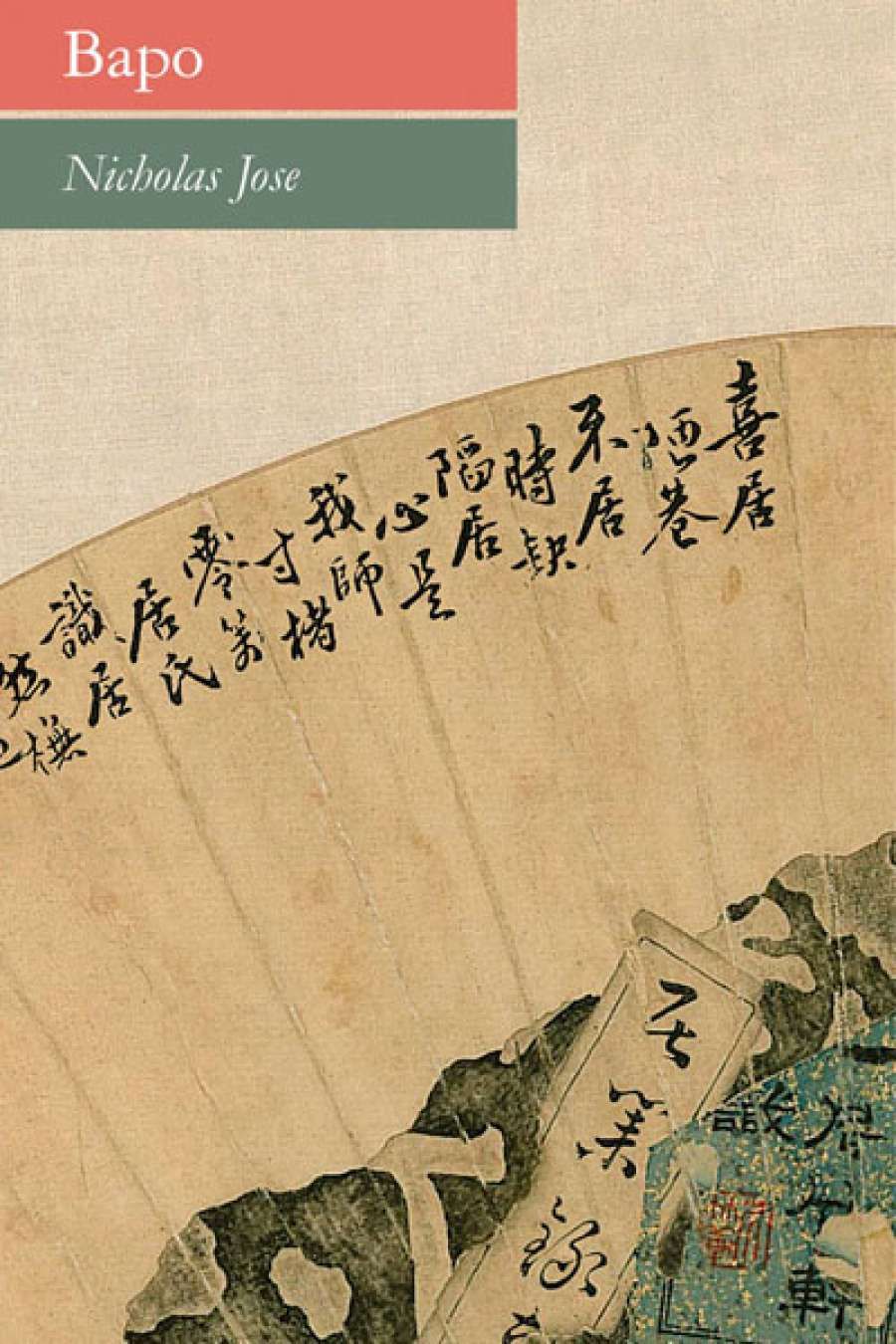
- Free Article: No
- Contents Category: Fiction
- Custom Article Title: Felicity Plunkett reviews 'Bapo' by Nicholas Jose
- Review Article: Yes
- Online Only: No
- Custom Highlight Text:
In Charles Simić’s book about Joseph Cornell’s assemblages, Dime-Store Alchemy (1992), he quotes his own translation of Croatian poet Slavko Mihalić to describe Cornell’s sculpture ‘Deserted Perch, 1949’, noting ‘the very tiny crack in which another world begins and ends’. Simićmarvels at this ‘Illusionist art ... sleight of hand’.
In the absorbing introduction to the stories in Bapo, Nicholas Jose describes bāpò as ‘an unusual kind of Chinese painting that tricks the eye into thinking it sees a collage of fragments’. Under the disguise of collection and assembly, the painter’s hand creates a trompe-l’œil of torn, burnt, pasted fragments. Jose describes his version as assemblage, and like Cornell, who reinvented discarded scraps and oddments, he finds in bāpò an ‘aesthetic of illusion and salvage, of creative retrieval’.
- Book 1 Title: Bapo
- Book 1 Biblio: Giramondo, $26.95 pb, 231 pp
The technique ‘appreciates incompleteness’, accenting the beauty of ‘the fragment, the shard’. Jose’s evocation of the mode highlights its recuperative energies – its hosting of the broken. Formally, ‘what looks like it comes from something damaged becomes part of something new’. Thematically, Jose’s focus is on similar resilience and reimagining.
This balancing of the illusion of assemblage – a gathering of found shards – against the concealed energies of careful crafting suggests the formal energies of the short story collection. Like a collection of poetry, it may simply be a gathering of pieces published over time, or it may be a livre composé. Here, an overarching project of stories ‘inflected by China’ unites the collection. Jose was cultural counsellor at the Australian Embassy from 1987 to 1990, and China has been at the heart of his oeuvre. He describes the stories as ‘pulled threads from the fabric that extends between China and Australia’.
‘Kong: Fossil’ maps migration from China to Australia, and the shapes and shards of an unsustainable identity, like the shell from a ‘dried-up inland sea’, a fossil discovered by a young man at the start of the story. Change is imagined as an impossible sea, its waters broken by the surfacing whale of democratic reform and its backlash.
‘Empress and Shaman’ and ‘A Game of Go’ explore trickery, manipulation, and the architecture of relationships. In ‘Empress and Shaman’, the friendship between two women has been curdled by competitiveness. The women and their husbands translate themselves between China and Australia. Shared memories lie under the present, a gluey palimpsest that holds the women together. They remember with an ‘uncanny sensation of return to an immutable point of reference’, sharing a ‘shuddering lift’ to the clinic in Hong Kong when each was pregnant. The story’s various lifts suggest history’s and narrative’s storeys, holding their layers as rooms hold ‘clutter, accumulation, discoveries, charms, poetry’. The women’s relationship mirrors China’s with Australia: ‘China growing and emerging, the West making a strategic withdrawal, redefining itself.’
‘A Game of Go’ explores similar power struggles between Princie, a Chinese dancer, and an Australian professor of Ming philosophy, Theo Weiss. Here, the strategies of two acquisitive men evoke the underbelly of cultural interchange, as Jose maps their byzantine operations of power.
 Nicholas Jose, 2014 (photograph courtesy of author)
Nicholas Jose, 2014 (photograph courtesy of author)
‘Marriage Bonds’ considers a married couple, Arthur and Martha, whose names suggest the neutralising bargain of their bond: again, manipulation and power struggles are the means by which they negotiate their stifling relationship. Pasted into their lives is their young bisexual lover, Robert, like an odd piece added to an assemblage. The couple draw closer as they measure the hurt inflicted on one another ‘like the balance of payments in an economy’. The ‘cruel theatre’ of their confected love-making distresses Robert, while their marriage – with its illusion of radical construction – stagnates. The story shifts around from past to present tense, the effect of which is to reinforce a sense of hasty pasting of the narrative of the marriage.
In a reflection of these motifs of triangulation and taunting, ‘Tripping’ examines youthful desire and hedonism and the ‘sly sorcery of youthful memory’. The protagonist listens to the woman he is drawn to, in bed with her lover, experiencing ‘unforgettably what I am excluded from’. Later, he reflects on the energy of ‘our unacted desire, our absolute and unspoken intimacy’.
‘Loving China’ is about alignment in love, reflected in a couple drawn together in their passion for China, their love taking on the shapes and nature of China’s ‘sinuous lines, its invisible veins of breath, its conduit aquifers; its yielding forbearance of give and take’.
Bāpò literally means ‘eight broken’, where the Chinese lucky number is damaged. These stories chart the negotiations and celebrations of survival, and of returning in new forms. Bapo’s last story, ‘Diamond Dog’, sees Lanlan, the daughter of Chinese immigrants to Australia, fretting: ‘How could she ever not be Chinese … if she always had a Chinese woman waiting for her outside school?’ and befriending Luke, with his ‘chopstick legs and peeled nut of a head’. When Luke and Lanlan are dressed for a school function, they swap skins: she dresses as Shane Warne, and he wears the Chinese dress and lopped plait she has cut off to sever her old self from her new. When she finds a python eating her puppy, she steps forward to beat it until the dog is disgorged, entering local legend at the same time. Bapo’s original, often unsettling stories observe people similarly caught between consuming and being consumed, and the crafting of a raft of renewals.


Comments powered by CComment